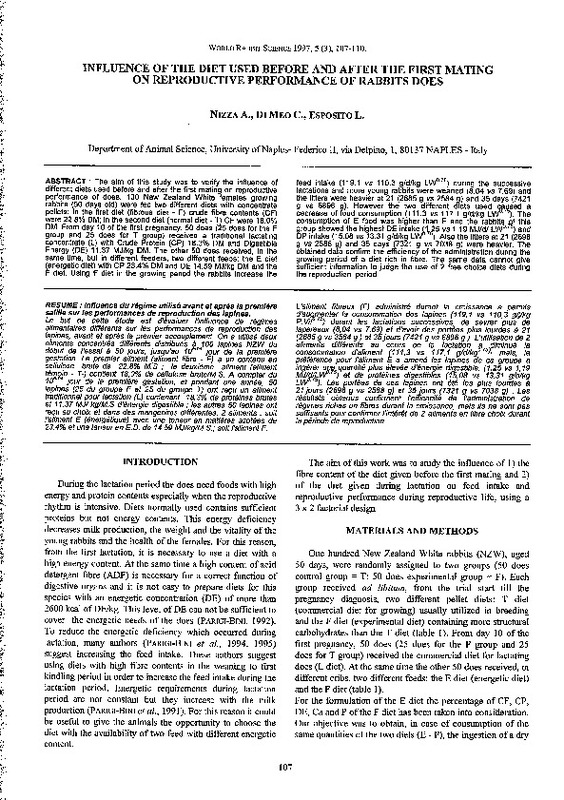JavaScript is disabled for your browser. Some features of this site may not work without it.
Buscar en RiuNet
Listar
Mi cuenta
Estadísticas
Ayuda RiuNet
Admin. UPV
INFLUENCE OF THE DIET USED BEFORE AND AFTER THE FIRST MATING ON REPRODUCTIVE PERFORMANCE OF RABBITS DOES
Mostrar el registro sencillo del ítem
Ficheros en el ítem
| dc.contributor.author | Nizza, A.
|
|
| dc.contributor.author | Di Meo, C.
|
|
| dc.contributor.author | Esposito, L.
|
|
| dc.date.accessioned | 2011-03-21T08:23:12Z | |
| dc.date.available | 2011-03-21T08:23:12Z | |
| dc.date.issued | 1997 | |
| dc.identifier.issn | 1257-5011 | |
| dc.identifier.uri | http://hdl.handle.net/10251/10422 | |
| dc.description.abstract | [EN] The aim of this study was to verify the influence of different diets used before and after the first mating on reproductive performance of does. 100 New Zealand White fema les growing rabbits (50 days old) were fed two different diets with concentrate pellets: in !he first diet (fibrous die! - F) crude fibre contents (CF) were 22.8% DM; in the second die! (normal die! - T) CF were 18.0% DM. From day 1 O of !he first pregnancy, 50 does (25 does for !he F group and 25 does for T group) received a traditional lactating concentrate (L) with Crude Protein (CP) 18.3% DM and Digestible Energy (DE) 11.37 MJ/kg DM. The other 50 does received, in !he same time, bu! in different feeders, two different feeds: the E die! (energetic die!) with CP 23.4% DM and DE 14.59 MJ/kg DM and !he F die!. Using F die! in !he growing period !he rabbits increase !he feed intake (119.1 vs 110.3 g/d/kg Lw0 · 75 ) during !he successive lactations and more young rabbits were weaned (8.04 vs 7.69) and !he litters were heavier at 21 (2685 g vs 2584 g) and 35 days (7421 g vs 6896 g). However !he two different diets used ~sed a decrease of food consumption (111.3 vs 117.1 g/d/kg LW · ). The consumption of E food was higher !han F and !he rabbit~ R,f this group showed the highest DE intake (y~5 vs 1.19 MJ/d/ LW'· ) and DP intake (15.08 vs 13.31 g/d/kg LW°· ). Also the litters at 21 (2698 g vs 2588 g) and 35 days (7321 g vs 7038 g) were heavier. The obtained data confirm the efficiency of !he administration during the growing period of a die! rich in fibre. The same data cannot give sufficient information to judge !he use of 2 free choice diets during !he reproduction period. | es_ES |
| dc.description.abstract | [FR] Le but de cette étude est d'évaluer f'ínfluence de régimes alimentaires différents sur les performances de reproduction des tapines, avant et aprés le premier accouplement. On a utilisé deux aliments concentrés différents distribués ~ 100 tapines NZW du début de l'essai a 50 jours, jusqu'au 1(f"18 jour de la premiare gestation. Le premier aliment (aliment fibre - F) a un contenu en ce/fu/ose brute de 22,8% M.S ; le deuxiéme aliment (aliment té!Join - T-) contient 18, 0% de ce/fu/ose brute/M. S. A compter du 1u me jour de la premiére gestation, et pendant une année, 50 tapines (25 du groupe F et 25 du groupe T) ont re9u un aliment traditionnel pour lactation (L) contenant 18,3% de protéines brutes et 11,37 MJ/ kg/M.S d'énergie digestible.; les autres 50 tapines ont re9u au choix et dans des mangeoires différentes, 2 aliments : soit l'aliment E (énergétique) avec une teneur en matieres azotées de 23,4% et une teneur en E.O. de 14,59 MJ/kg/M.S.; soit /'aliment F. L 'aliment fibreux (F) administré durant la croissance a permis d'augro~nter la consommation des lapines (119, 1 vs 110,3 g/jlkg P. Vif'·') durant les lactations successives, de sevrer plus de lapereaux (8,04 VS 7,69) et d'avoir des porfées pfUS lourdes B 21 (2685 g vs 2584 g) et 35jours (7421 g vs 6896 g ). L'utilisation de 2 a/iments différents au cours de la lactation ~751diminué la consommation d'aliment (111,3 vs 117, 1 g/dlkfj'· ~· mais, la préférence pour /'aliment E a amené les lapines de ce groupe a ingérer UIJ~ quantité plus élevée d'énergie digestible. (1,25 vs 1, 19 MJ/f;llLW'· 5 ) et de protéines digestibles (15,08 vs 13,31 g/dlkg LW'·"'). Les portées de ces lapines ont été les plus lourdes a 21 jours (2698 g vs 2588 g) et 35 jours (7321 g vs 7038 g) . Les résultats obtenus confirment l'efficacité de /'administration de régimes riches en fibres durant la croissance, mais ils ne sont pas suffisants pour confirmer f'íntérét de 2 aliments en libre choix durant la période de reproduction. | |
| dc.description.sponsorship | Research partly supported by CNR, Italy | |
| dc.language | Inglés | es_ES |
| dc.publisher | World Rabbit Science. ICTA. UPV | es_ES |
| dc.relation.ispartof | World Rabbit Science | |
| dc.rights | Reserva de todos los derechos | es_ES |
| dc.title | INFLUENCE OF THE DIET USED BEFORE AND AFTER THE FIRST MATING ON REPRODUCTIVE PERFORMANCE OF RABBITS DOES | es_ES |
| dc.type | Artículo | es_ES |
| dc.date.updated | 2011-03-21T08:15:56Z | |
| dc.identifier.doi | 10.4995/wrs.1997.327 | es_ES |
| dc.rights.accessRights | Abierto | es_ES |
| dc.description.bibliographicCitation | Nizza, A.; Di Meo, C.; Esposito, L. (1997). INFLUENCE OF THE DIET USED BEFORE AND AFTER THE FIRST MATING ON REPRODUCTIVE PERFORMANCE OF RABBITS DOES. World Rabbit Science. 05(3):107-110. https://doi.org/10.4995/wrs.1997.327 | es_ES |
| dc.description.accrualMethod | SWORD | es_ES |
| dc.relation.publisherversion | https://doi.org/10.4995/wrs.1997.327 | es_ES |
| dc.description.upvformatpinicio | 107 | |
| dc.description.upvformatpfin | 110 | |
| dc.description.volume | 05 | |
| dc.description.issue | 3 | |
| dc.identifier.eissn | 1989-8886 | es_ES |
| dc.contributor.funder | Consiglio Nazionale delle Ricerche, Italia |








